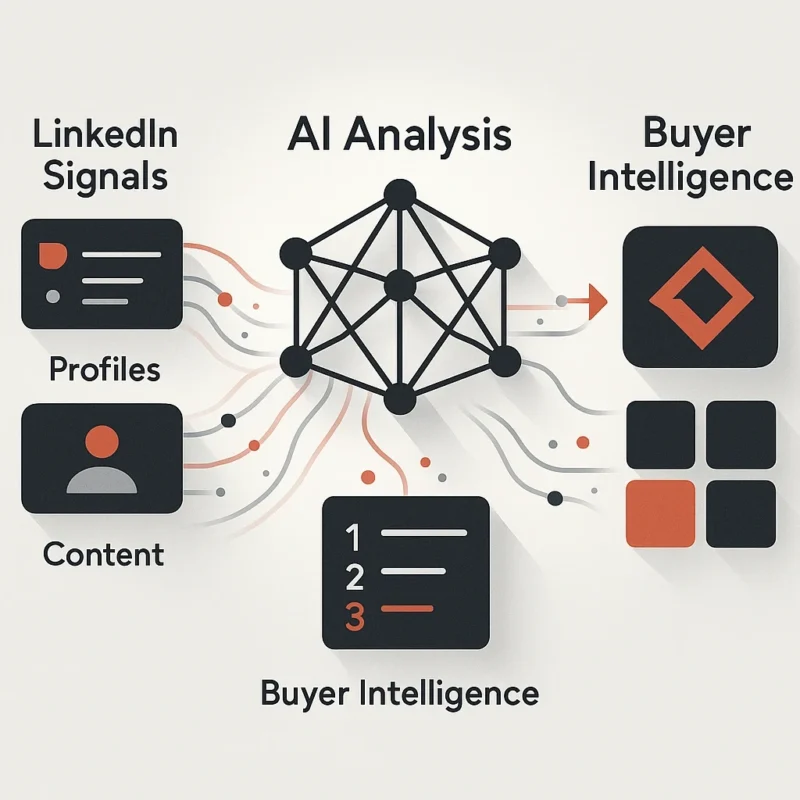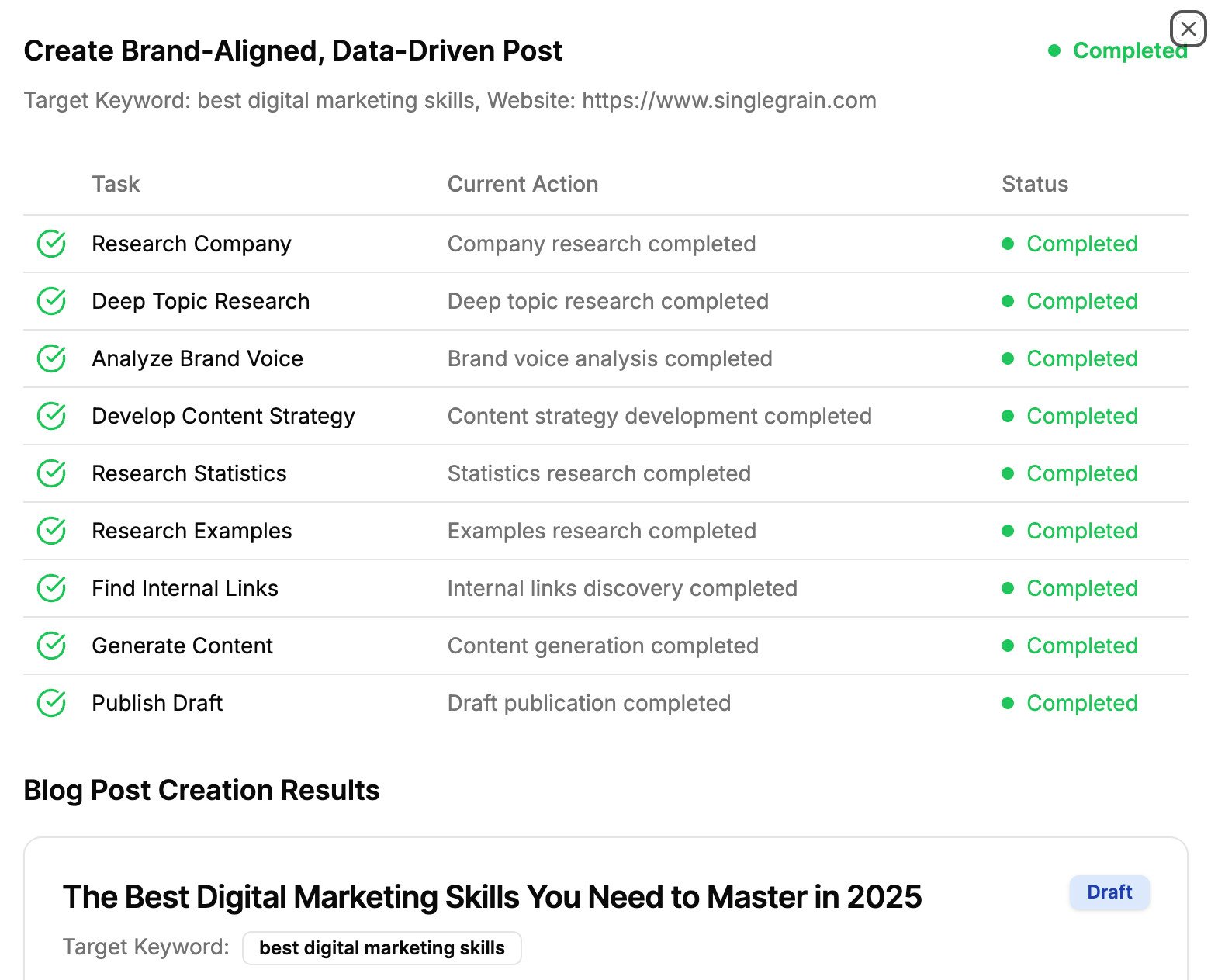Your sales team is drowning in LinkedIn engagement data, but only 3% of those “interested” prospects actually convert. Meanwhile, your highest-value accounts are slipping through the cracks because traditional ABM approaches can’t distinguish between casual browsing and genuine buying intent. The solution lies in AI-powered analysis of LinkedIn ABM intent data. A methodology that transforms noisy engagement signals into precise buyer intelligence.
Recent data from enterprise LinkedIn ABM campaigns reveals that AI-powered optimization delivers a 37% higher engagement rate and 42% reduction in lead costs. This isn’t just about efficiency. It’s about fundamentally changing how you identify and engage your most valuable prospects.
TABLE OF CONTENTS:
Understanding LinkedIn ABM Intent Data vs. Basic Engagement Signals
The biggest mistake in LinkedIn ABM analysis is treating every interaction as equal. A CFO downloading your pricing guide carries vastly different intent weight than a junior analyst liking your company update. AI-powered analysis distinguishes between these signals by examining behavioral patterns, timing, and stakeholder involvement.
LinkedIn ABM intent data encompasses several crucial signal types that AI can interpret more accurately than manual analysis. Profile visits from multiple stakeholders within a target account, especially when they occur within a compressed timeframe, indicate coordinated research efforts. Content engagement depth, measured by time spent reading whitepapers, watching product demos, or interacting with pricing content, reveals genuine interest versus passive consumption.
“LinkedIn Lead Gen Forms deliver an average 13% conversion rate. Over 5× the typical landing-page benchmark,” according to recent industry analysis. This higher conversion rate occurs because these forms capture buyer-intent signals at the moment of peak engagement, providing richer datasets for AI analysis.
Search behavior within LinkedIn provides another layer of intent data. When prospects search for your company name, competitors, or industry-specific solution terms, AI can correlate these searches with other engagement signals to build comprehensive intent scores. Job posting analysis also reveals buying intent. Companies hiring for roles that would use your solution often indicate expansion or new implementation plans.
The 4-Step AI-Powered Analysis Framework
Successful LinkedIn ABM intent analysis follows a systematic approach that leverages AI at each stage. This framework transforms scattered engagement data into actionable account intelligence that drives revenue growth.

Step 1: Continuous Monitoring and Data Collection
AI-powered monitoring goes beyond basic engagement tracking to capture nuanced behavioral patterns. Advanced systems monitor not just what prospects do, but when they do it, how long they spend on activities, and which content resonates most strongly. This includes tracking content consumption patterns, measuring engagement velocity, and identifying stakeholder mapping within target accounts.
The monitoring phase establishes baseline behavioral patterns for each account. AI algorithms learn normal engagement levels, preferred content types, and typical interaction frequencies. This baseline becomes crucial for detecting significant changes that indicate shifting buying intent.
Step 2: Signal Detection and Correlation
This phase represents where AI demonstrates its greatest value over manual analysis. Machine learning algorithms identify patterns across thousands of data points that would be impossible for humans to process. The system correlates seemingly unrelated activities, a pricing page visit followed by competitor research, multiple stakeholder LinkedIn profile views, and increased content engagement, to identify coordinated buying behavior.
Advanced correlation analysis examines timing patterns, stakeholder involvement, and content progression. When multiple decision-makers from the same account engage with solution-specific content within a short timeframe, AI recognizes this as a high-intent signal. The system also identifies negative correlation patterns, such as decreased engagement following competitor interactions, which might indicate lost opportunities.
Step 3: Predictive Analysis and Scoring
Predictive AI models analyze current intent signals against historical conversion data to forecast buying probability and timeline. These models consider account characteristics, industry patterns, seasonal trends, and engagement trajectories to generate dynamic intent scores that update in real-time.
The scoring system typically operates on multiple dimensions: buying readiness (how likely they are to purchase), timeline prediction (when they’re likely to buy), deal size potential (based on company characteristics and engagement depth), and churn risk (for existing customers showing intent around alternatives). Each dimension receives weighted scores that combine into comprehensive account intelligence.
Step 4: Intelligent Activation and Personalization
The final phase translates intent insights into precise marketing and sales actions. AI-driven activation goes beyond simple lead routing to provide specific guidance on messaging, timing, and channel selection. High-intent accounts receive immediate sales attention with personalized outreach based on their specific engagement patterns and identified pain points.
Activation includes automated workflow triggers, personalized content recommendations, and dynamic ad targeting adjustments. When intent scores cross predetermined thresholds, the system automatically notifies relevant sales team members, updates CRM records, and adjusts LinkedIn ad targeting to increase share of voice with high-intent accounts.
Turning Intent Signals Into Strategic Account Prioritization
Effective account prioritization requires more than simple intent scoring. It demands strategic alignment between intent strength, account value, and resource allocation. The most successful teams use AI-powered prioritization matrices that balance multiple factors to optimize both short-term wins and long-term pipeline value.
High-intent, high-value accounts receive immediate sales attention with personalized, multi-channel outreach. These accounts often show coordinated research behavior across multiple stakeholders, deep engagement with solution-specific content, and recent trigger events like funding announcements or leadership changes. AI helps identify the optimal contact timing and messaging approach based on engagement patterns and similar account analysis.
| Account Tier | Intent Score Range | Recommended Actions | Resource Allocation |
|---|---|---|---|
| Tier 1: Hot Prospects | 85-100 | Immediate sales outreach, executive engagement, custom demos | 60% of sales time |
| Tier 2: Warm Leads | 60-84 | Nurture sequences, targeted content, regular check-ins | 25% of sales time |
| Tier 3: Future Opportunities | 30-59 | Brand awareness campaigns, educational content, quarterly touchpoints | 10% of sales time |
| Tier 4: Low Priority | Below 30 | Automated nurture, broad content distribution | 5% of sales time |
Medium-intent accounts with high strategic value represent long-term pipeline opportunities that require consistent nurturing. AI helps maintain engagement through automated content distribution, triggered outreach based on behavior changes, and strategic brand visibility campaigns. These accounts often convert at higher rates when properly nurtured over extended periods.
Research from Gartner demonstrates the impact of intent-driven prioritization: organizations executing ABM see a 28% uptick in overall account engagement, and 75% report engaging buyers earlier in the funnel. This early engagement advantage comes from AI’s ability to detect buying signals before competitors recognize the opportunity.
Advanced AI Techniques for Buyer Signal Detection
Sophisticated AI analysis employs multiple techniques to extract maximum intelligence from LinkedIn ABM data. Natural language processing analyzes LinkedIn posts, comments, and shared content to identify pain points, priorities, and solution requirements. Sentiment analysis determines whether prospect engagement indicates positive interest or competitive research.
Behavioral sequence analysis identifies buying journey progression by mapping engagement patterns against known conversion paths. AI recognizes when prospects move from awareness-stage content (industry reports, trend analysis) to consideration-stage materials (product comparisons, case studies) to decision-stage resources (pricing information, implementation guides).

Lookalike modeling expands target account identification by analyzing characteristics of high-converting accounts and finding similar companies within LinkedIn’s database. This technique helps identify new prospects who share behavioral and demographic patterns with successful customers, expanding ABM reach while maintaining conversion quality.
Anomaly detection alerts teams to significant changes in account behavior that might indicate urgent buying situations or competitive threats. When established engagement patterns suddenly shift, such as decreased activity following steady engagement, AI flags these accounts for immediate attention.
Measuring Success and Optimizing Your AI-Driven Approach
Effective measurement of AI-powered LinkedIn ABM requires metrics that go beyond traditional engagement tracking. Pipeline velocity becomes a crucial indicator. High-intent accounts identified through AI analysis should demonstrate faster progression through sales stages. Conversion rate optimization focuses on the lift achieved through AI-powered prioritization versus traditional approaches.
Revenue attribution analysis tracks the complete customer journey from initial LinkedIn engagement through closed deals. Advanced attribution models account for multiple touchpoints, weighting them based on their position in the buying journey and their correlation with successful outcomes. This comprehensive approach demonstrates the true ROI of AI-powered intent analysis.
Real-world results demonstrate the transformative potential of this approach. Adobe Cloud’s implementation of LinkedIn ABM with AI-driven buyer signal scoring resulted in a 161% increase in closed deals, with the majority of growth attributed directly to intent-data-driven ABM motions.
Continuous optimization requires regular model refinement based on conversion outcomes. Successful teams review AI scoring accuracy monthly, adjusting signal weights and introducing new data sources as they identify patterns. This iterative approach ensures the system becomes more accurate over time, delivering compound returns on the initial AI investment.
Your Implementation Roadmap: From Setup to Scale
Beginning your AI-powered LinkedIn ABM journey requires careful planning and phased implementation. Start by auditing your current data collection capabilities and identifying gaps in your intent signal tracking. Most organizations underestimate the breadth of data required for effective AI analysis, focusing only on obvious engagement metrics while missing crucial behavioral indicators.
Phase one involves establishing comprehensive data collection across all LinkedIn touchpoints. This includes implementing proper tracking for content engagement, profile visits, ad interactions, and search behaviors. Integration with your CRM system ensures intent data flows directly into sales workflows, providing immediate actionable intelligence.
Phase two focuses on AI model training using your historical conversion data. The system learns from your past successes, identifying the specific signal combinations that predict buying behavior in your industry and customer base. Initial models typically achieve 60-70% accuracy, improving to 85%+ as they process more data.
Phase three scales the system across your entire ABM program, incorporating advanced techniques like predictive scoring, automated activation, and continuous optimization. Teams often see dramatic results within 90 days of full implementation, with continued improvement over 6-12 months as AI models refine their accuracy.
For organizations ready to accelerate their LinkedIn ABM success with AI-powered intent analysis, specialized platforms can significantly reduce implementation time while ensuring best-practice methodology. Tools like Karrot.ai offer integrated solutions that combine LinkedIn data analysis with automated personalization and attribution tracking. Get a Free Audit to discover how AI-powered ABM analysis can transform your pipeline generation and deal velocity.
The integration of AI with LinkedIn ABM intent data represents a fundamental shift in B2B marketing effectiveness. Organizations that master this approach gain sustainable competitive advantages through superior account intelligence, precise targeting, and accelerated revenue growth. As AI-powered ABM continues evolving, early adopters position themselves to capture disproportionate market share through superior buyer intelligence and engagement precision.
Success in 2025’s competitive landscape requires more than traditional ABM approaches. It demands the intelligent amplification that only AI-powered intent analysis can provide. The question isn’t whether to implement these capabilities, but how quickly you can deploy them to capture the substantial competitive advantages they create.
Ready to stop guessing which LinkedIn prospects will actually buy and start knowing?
Frequently Asked Questions
-
What's the difference between LinkedIn ABM intent data and basic engagement signals?
Intent data analyzes behavioral patterns, timing, and stakeholder involvement to distinguish genuine buying interest from casual browsing. While basic engagement tracks likes and views, intent data examines deeper signals like coordinated research efforts across multiple stakeholders, content engagement depth, and search behavior patterns.
-
How does AI improve LinkedIn ABM analysis compared to manual methods?
AI can process thousands of data points simultaneously to identify patterns that humans would miss, such as correlating seemingly unrelated activities across multiple stakeholders. It also provides real-time scoring, predictive analysis, and can detect subtle behavioral changes that indicate shifts in buying intent.
-
What are the four steps in the AI-powered analysis framework?
The framework includes: 1) Continuous monitoring and data collection to establish behavioral baselines, 2) Signal detection and correlation to identify buying patterns, 3) Predictive analysis and scoring to forecast buying probability and timeline, and 4) Intelligent activation and personalization for targeted outreach.
-
How should I prioritize accounts based on AI-generated intent scores?
Accounts with intent scores of 85-100 should receive immediate sales attention and 60% of your resources, while scores of 60-84 warrant nurture sequences and 25% allocation. Lower-scoring accounts receive automated nurturing with minimal resource investment.
-
What advanced AI techniques can detect buyer signals beyond basic engagement?
Advanced techniques include natural language processing to analyze LinkedIn posts for pain points, behavioral sequence analysis to track buying journey progression, and lookalike modeling to identify similar high-converting prospects. Anomaly detection also alerts teams to sudden changes in engagement patterns.
-
How do I measure the success of AI-powered LinkedIn ABM?
Focus on pipeline velocity improvements, conversion rate lifts compared to traditional approaches, and complete revenue attribution from LinkedIn engagement to closed deals. Track how quickly high-intent accounts progress through sales stages and monitor AI scoring accuracy monthly for continuous optimization.
-
What's the typical implementation timeline for AI-powered LinkedIn ABM?
Implementation follows three phases: establishing comprehensive data collection, training AI models on historical data (achieving 60-70% initial accuracy), and scaling across your ABM program. Most teams see dramatic results within 90 days of full implementation, with accuracy improving to 85%+ over 6-12 months.





